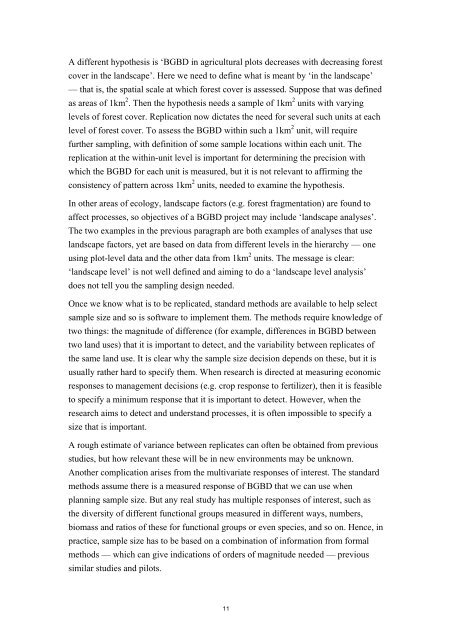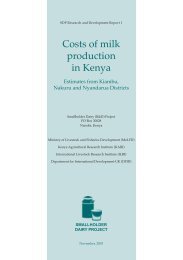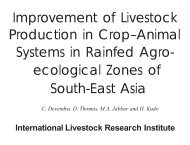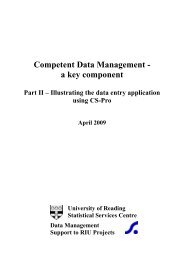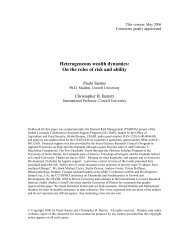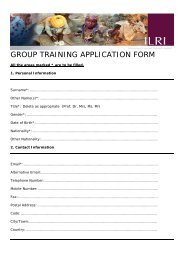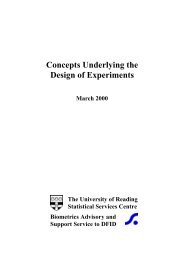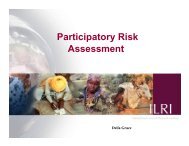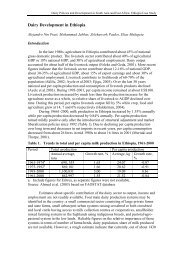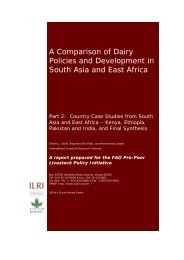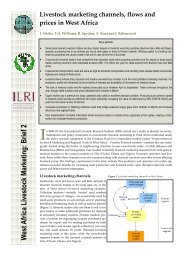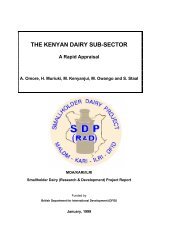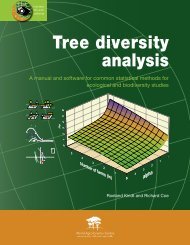Designing ecological and biodiversity sampling strategies
Designing ecological and biodiversity sampling strategies
Designing ecological and biodiversity sampling strategies
You also want an ePaper? Increase the reach of your titles
YUMPU automatically turns print PDFs into web optimized ePapers that Google loves.
A different hypothesis is ‘BGBD in agricultural plots decreases with decreasing forestcover in the l<strong>and</strong>scape’. Here we need to define what is meant by ‘in the l<strong>and</strong>scape’— that is, the spatial scale at which forest cover is assessed. Suppose that was definedas areas of 1km 2 . Then the hypothesis needs a sample of 1km 2 units with varyinglevels of forest cover. Replication now dictates the need for several such units at eachlevel of forest cover. To assess the BGBD within such a 1km 2 unit, will requirefurther <strong>sampling</strong>, with definition of some sample locations within each unit. Thereplication at the within-unit level is important for determining the precision withwhich the BGBD for each unit is measured, but it is not relevant to affirming theconsistency of pattern across 1km 2 units, needed to examine the hypothesis.In other areas of ecology, l<strong>and</strong>scape factors (e.g. forest fragmentation) are found toaffect processes, so objectives of a BGBD project may include ‘l<strong>and</strong>scape analyses’.The two examples in the previous paragraph are both examples of analyses that usel<strong>and</strong>scape factors, yet are based on data from different levels in the hierarchy — oneusing plot-level data <strong>and</strong> the other data from 1km 2 units. The message is clear:‘l<strong>and</strong>scape level’ is not well defined <strong>and</strong> aiming to do a ‘l<strong>and</strong>scape level analysis’does not tell you the <strong>sampling</strong> design needed.Once we know what is to be replicated, st<strong>and</strong>ard methods are available to help selectsample size <strong>and</strong> so is software to implement them. The methods require knowledge oftwo things: the magnitude of difference (for example, differences in BGBD betweentwo l<strong>and</strong> uses) that it is important to detect, <strong>and</strong> the variability between replicates ofthe same l<strong>and</strong> use. It is clear why the sample size decision depends on these, but it isusually rather hard to specify them. When research is directed at measuring economicresponses to management decisions (e.g. crop response to fertilizer), then it is feasibleto specify a minimum response that it is important to detect. However, when theresearch aims to detect <strong>and</strong> underst<strong>and</strong> processes, it is often impossible to specify asize that is important.A rough estimate of variance between replicates can often be obtained from previousstudies, but how relevant these will be in new environments may be unknown.Another complication arises from the multivariate responses of interest. The st<strong>and</strong>ardmethods assume there is a measured response of BGBD that we can use whenplanning sample size. But any real study has multiple responses of interest, such asthe diversity of different functional groups measured in different ways, numbers,biomass <strong>and</strong> ratios of these for functional groups or even species, <strong>and</strong> so on. Hence, inpractice, sample size has to be based on a combination of information from formalmethods — which can give indications of orders of magnitude needed — previoussimilar studies <strong>and</strong> pilots.11


